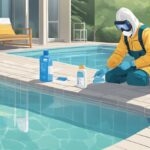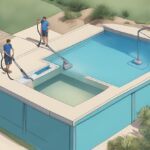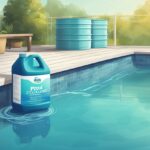Maintaining balanced water chemistry is essential for a healthy swimming pool, and cyanuric acid (CYA) plays a crucial role in protecting your chlorine from sunlight degradation. However, when CYA levels rise above the optimal range, typically between 30 to 50 parts per million (ppm), it reduces chlorine’s effectiveness in sanitising your pool. Therefore, it’s important to regularly test your water and take steps to lower CYA levels if they become too high.

If your tests indicate that CYA concentrations exceed the recommended levels, there are several methods to bring it back into balance. Dilution through partial draining and refilling with fresh water is the most straightforward approach and can significantly lower CYA concentrations. Another is utilising a cyanuric acid reducer, which is a chemical product designed to decrease CYA levels in pool water. Remember that achieving and maintaining the right CYA balance is key for pool health and ensuring safe, clean swimming conditions.
Understanding CYA and Its Impact on Pool Water
In this section, you’ll gain insight into the significance of cyanuric acid for maintaining pool water chemistry, as well as how to identify when its levels have become excessive.
The Role of Cyanuric Acid in Water Chemistry
Cyanuric acid (CYA) acts as a stabiliser for chlorine, helping to protect it from degradation under UV light. This extends the effective life of chlorine in your pool water, enabling it to sanitize the pool effectively.
- Stabilised Chlorine: Chlorine that’s protected by CYA is often referred to as ‘stabilised chlorine’.
- Free Chlorine: This is the chlorine that’s actively sanitising your pool. CYA helps maintain free chlorine levels by reducing the rate at which chlorine is broken down by sunlight.
For an optimal balance:
- Aim for CYA levels between 30 and 50 parts per million (ppm).
- Ensure free chlorine is present at a concentration of approximately 1 to 3 ppm for safe swimming conditions.
Identifying High CYA Levels
To determine whether your pool has high CYA levels, you need to conduct regular testing using reliable test strips or test kits:
- Collect a Water Sample from your pool, ensuring it’s from at least an arm’s length below the surface to avoid any contaminated surface water.
- Use Test Strips or a Test Kit designed for CYA detection. Follow the instructions precisely, looking for a colour change or other indicator for CYA concentration.
High CYA levels, typically above 50 ppm, can cause chlorine to become less effective at sanitizing your pool, which may lead to issues such as algae growth or unsafe water conditions. Track the levels regularly, as routine maintenance can prevent the CYA from reaching levels that would require more drastic corrective actions.
Effective Methods to Lower CYA
Lowering Cyanuric Acid (CYA) levels in your pool is vital for maintaining water balance and chlorine effectiveness. Two reliable techniques are draining with subsequent refilling and utilising specialised chemicals.
Draining and Partially Refilling the Pool
Partial Draining: To reduce high CYA levels, you can partially drain your pool. Use a submersible pump to remove the necessary volume of water, then add fresh water to dilute the remaining pool water.
- Steps:
- 1. Determine the amount of water to remove, which correlates with how much you need to lower CYA.
- 2. Position the submersible pump and drain the calculated amount of water to waste.
- 3. Refill the pool with fresh water, restoring it to the appropriate water level.
Note: Always monitor the pool’s chemistry after refilling to ensure proper CYA levels.
Using CYA Reducers and Chemicals
CYA Reducers: Specialised CYA reducing products, such as bio-active or commercial cyanuric acid reducers, chemically lower the CYA content in your pool.
- Directions:
- 1. Follow the manufacturer’s instructions precisely for the selected CYA reducer.
- 2. Apply the product to your pool as directed, ensuring even distribution.
Chemical Adjustments: Adjusting other chemical levels can also indirectly help manage CYA concentration.
- Potential Adjustments:
- Muriatic Acid: Lowering pH levels might slightly influence CYA, but this is generally not as effective as other methods.
- Phosphate Treatments: They are sometimes recommended but primarily target algae prevention and are not direct CYA reducers.
Maintaining Optimal CYA Levels
Cyanuric acid (CYA) levels in your pool are crucial for protecting chlorine from sunlight and maintaining water sanitation. Maintaining the CYA within an ideal range is integral to the health of your pool’s water chemistry.
Regular Testing and Monitoring
To ensure your pool remains in top condition, regular testing of your water chemistry is key. Use an accurate testing kit to measure the levels of CYA, which should ideally fall within the range of 30 to 50 parts per million (ppm). Reliable testing not only tracks CYA but also pH levels and total alkalinity.
- CYA: Every 2 weeks
- pH Level: 1-2 times a week
- Total Alkalinity: Every 2 weeks
Strategies for Balancing Water Chemistry
Balancing your pool’s water chemistry involves adjusting CYA levels whilst considering factors like pH level and total alkalinity. To achieve a balanced state:
- Adjust CYA: If your CYA levels exceed 50 ppm, consider partially draining your pool and refilling it with fresh water.
- pH Adjustments: Ensure your pH stays within 7.2-7.6. As CYA levels can affect stabiliser efficiency, maintaining the pH can indirectly affect CYA stability.
- Alkalinity: Maintain total alkalinity between 80-120 ppm to support pH balance and stabiliser effectiveness.
By regularly testing and monitoring, coupled with informed balancing strategies, you’ll keep your pool’s water chemistry in check, ensuring a safe and pleasant swimming environment.











